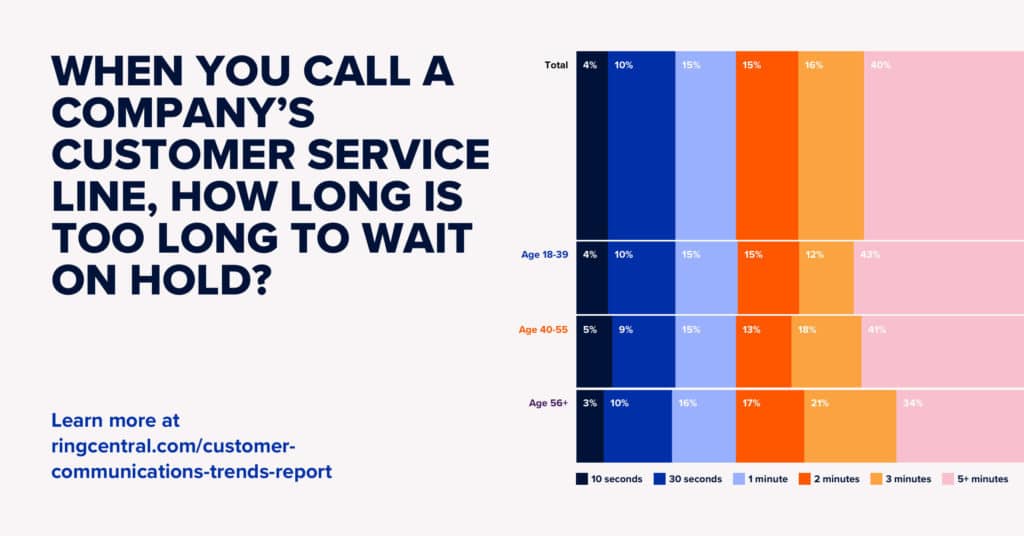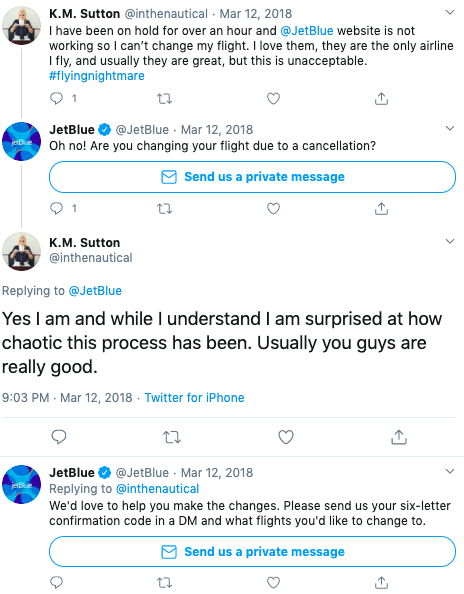You’ve heard it all before:
“The customer is always right…”
“Don’t forget to smile…”
“First impressions are everything…”
But beyond the obvious clichés and soundbite advice, what does it actually take to develop a solid customer service strategy?
How can you build a customer service process that ensures a positive and pain-free experience for everyone who comes into contact with your brand?
You start with your fundamental customer service principles, of course.
In this post, we’ll look at:
- Why you need a customer service philosophy
- 9 foundational principles of outstanding customer service
- 3 real-life examples of customer service philosophy in action
So let’s start by looking at why you should develop a customer service philosophy in the first place.
⭐️⭐️⭐️⭐️⭐️ Ready to offer 5-star customer service? Get strategies for every stage of the customer journey with this free eBook.
Why you need a customer service philosophy
A customer service philosophy is an overarching ethos that guides your business in all its customer interactions.
Different businesses have different attitudes toward customer service. For some, customer service is just another business function, while for others it plays a decisive role in maintaining a competitive advantage.
The truth is you can’t sleep on building your team’s customer service skills if you care about sustainable business growth. The benefits of good service are too great—and the costs of bad service are just too steep.
Benefits of good customer service
- Word-of-mouth: Happy customers spread the word: 67% of customers will recommend your product or service to other people after a good customer experience.1
- Retention: Good customer service improves the odds of your customer buying again: 87% of customers are likely to buy from you again after a great experience.2 Learn more about improving your customer retention rate.
- Higher-paying customers: Customers will even pay more to do business with you if you’re known for having stellar customer service: 67% of consumers and 74% of business customers will pay a premium for a great experience.3
Costs of bad customer service
- Word-of-mouth: Disappointed customers are also inclined to spread the word: the average American tells their bad customer service stories to 15 people.4
- Customer churn: The variety of options available means your customers can simply switch to brands that offer a better customer experience: 33% of Americans will consider switching companies after one instance of bad service.5
- Acquisition costs: Losing customers puts the focus on gaining new ones—and customer acquisition costs up to 7 times more than customer retention.6
Clearly, providing great customer service isn’t just a matter of common decency; it also makes a lot of business sense.
But what exactly is “great” service? What are the key ingredients? And how can you achieve it reliably and efficiently?
These are the questions your customer service philosophy will help answer.
To help hone your own philosophy, we’ve collected nine core principles that form the foundation of outstanding customer service.
9 foundational principles of outstanding customer service
1. Responsiveness
Response time is probably one of the biggest factors affecting customer service satisfaction. In fact, in the Customer Communications Review, 60% of respondents thought that waiting on hold for anywhere from 10 seconds to 3 minutes was too long:
This is hardly surprising. We’ve all felt the agony of being put on hold for way too long.
The two most important metrics to bear in mind when looking to develop fast customer service are first-response time and first-call resolution, or first-contact resolution ratio.
First-response time refers to how long it takes an agent to respond after a customer first reaches out. A short first-response time reassures the customer that their problem has been registered and that someone’s working on it.
First-contact resolution ratio refers to the proportion of customer issues that are resolved in one go. Fun fact: up to 67% of customer churn is preventable if problems are solved when the customer first raises them.7
Factors affecting responsiveness:
- Agent’s knowledge: The more your customer service agent knows about your product or service, the more likely it is they’ll have an on-hand solution to your customer’s problem.
- Agent’s autonomy: The more decision-making power your agent has, the quicker they’ll be able to implement an unconventional solution when necessary.
- Channel used: Response time depends on the support channel you use. Email is slower; live chat is quicker. Ideally, you’d have a communications tool that gives you different options. For example, RingCentral’s omni-digital customer engagement platform lets you talk to your customers through whatever channel they prefer, from phone calls to emails to live-chat:
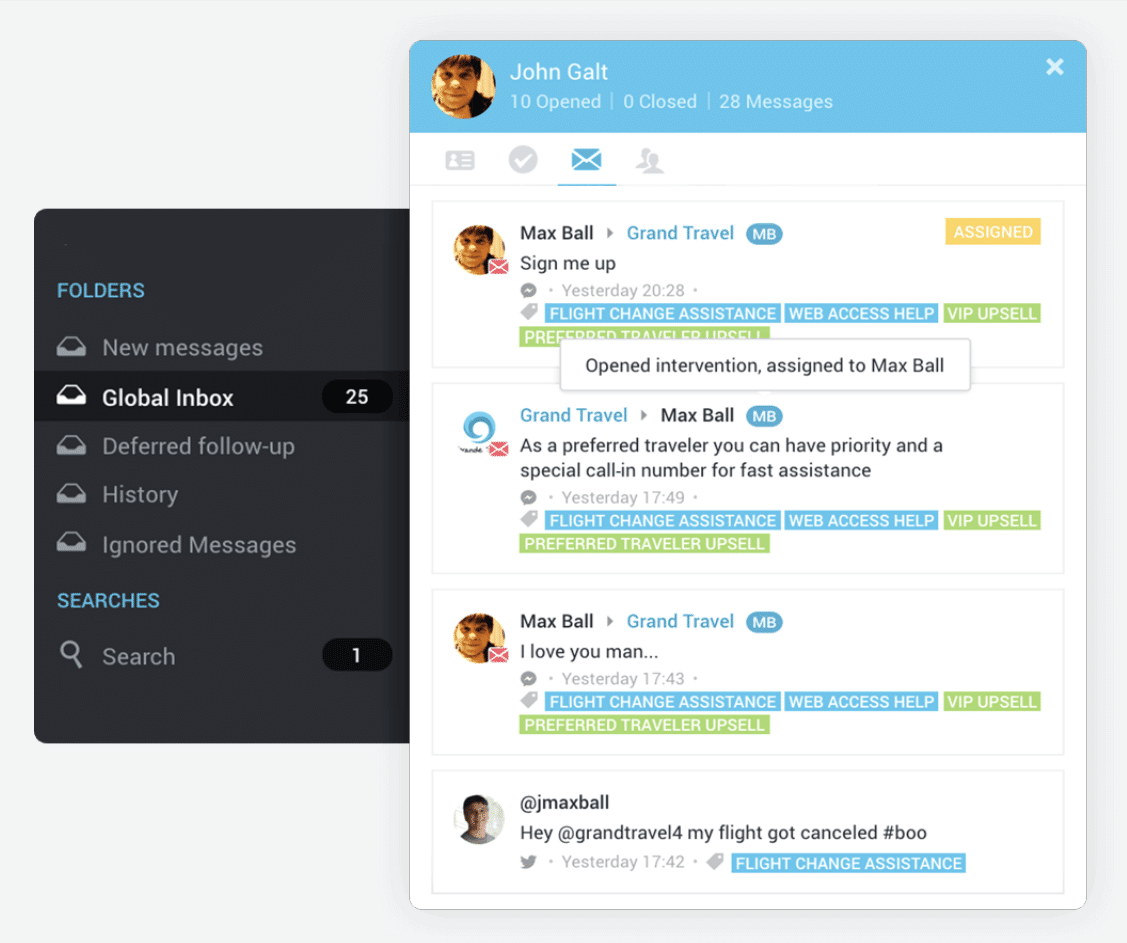
2. Know-how
Reps with a strong understanding of your product or service are better equipped to give accurate answers to specific customer questions.
This won’t just minimize mistakes; it’ll make your customers feel confident that their problem is being dealt with by a competent pair of hands.
Knowledgeable agents are key to a better customer experience: 33% of customers say that speaking to an agent that knows their stuff is the most important aspect of customer service.8
Factors affecting know-how:
- Training: The more your agents learn about your product or service, the better they’ll be at troubleshooting customer issues accurately.
- Information management: Your agents can apply their knowledge more effectively when they have immediate access to background information about the customer and their specific problem.
3. Effortlessness
You should try to make your customer service as easy to access and understand as possible.
Chances are your customers are already preoccupied with the problem or question they’re contacting you about. The last thing they need is to jump through a bunch of hoops to get to you.
Factors affecting effortlessness:
- Clarity: Your communication should be easy to grasp. Customers should be in no doubt about what you mean. This applies just as much to your content as it does to how your agents talk to customers. Use simple, familiar words and phrases when you can.
- Support channels: How clearly are your different contact channels listed on your website? How clear are the instructions about how to access and use them?
- Content: Comprehensive and easy-to-access FAQ content can help customers solve problems themselves.
4. Consistency
Inconsistent brand interactions can leave your customers with a bad impression.
It’s important to do all you can to ensure that customers receive the same quality of service across all your communication channels.
Kate Leggett explains this in a Forrester Research analysis of consistency in customer service9:
“Customers expect the same experience every time they interact with a company—whether it be when researching a product, completing a sales transaction, or getting customer service—over all the communication channels that a company offers.”
In fact, consistency can play a big role in customer loyalty, with up to 73% of customers willing to switch brands if they don’t receive consistent experiences across different channels.10
Factors affecting consistency:
- Aligning outbound and inbound strategy: Companies often deliver a different experience when handling inbound calls and communications (when customers reach out to you) versus outbound (when you reach out to them). This can lead to confusion if your customer service teamwork isn’t consistent across both channels.
- Consolidating customer history: A common frustration for customers is having to repeat themselves when they’re being transferred from agent to agent. You can avoid duplicate conversations by making sure your team has a comprehensive history of the customer’s interactions ready whenever they’re on a call.
- Consistent routing: Make sure that customer inquiries arriving from different support channels are all routed the same way so that no one channel is neglected.
5. Openness
Maintaining a level of honesty and openness with your customers can go a long way toward earning their trust and respect.
For example, it’s okay to let the customer know if you’re unsure of something. You can tell them that you’ll look into it and to give them the answer as soon as you can.
Likewise, for most people, waiting isn’t so bad. What gets people agitated is not knowing why they’re waiting, or for how long they’ll have to wait.
The key here is to keep your customers in the loop so they aren’t left hanging.
Factors affecting openness:
- Over-eager troubleshooting: It can be tempting to jump right into solving the customer’s problem once you think you understand what it is. But it’s always worth informing the customer of what you’re doing and how long they can expect to wait while you fix the issue—even if doing so slows you down a little.
- Customer feedback methods: Encourage customers to give their honest feedback. Not only does this give you valuable qualitative data, but it also signals to customers that you’re serious about improving your service.
6. A human touch
Politeness, personality, and empathy are key human traits that make all the difference in creating an inviting customer experience.
People don’t like feeling like they’re interacting with a faceless, soulless machine, and they certainly don’t want to be treated like one themselves!
A human touch is indispensable: 73% of customers stick with a brand because of the memorable experiences created by friendly employees.11
Similarly, 68% of customers think being assigned a pleasant agent is key to a positive customer service experience.12
Showing that you care about the individual at the other end—including their problems and goals—will leave your customers feeling uniquely appreciated.
Factors affecting a human touch:
- Customer focus: Instead of emphasizing your company in your messaging, focus on how your company can help customers with their problems.
- Personalized messaging: Build stronger personal connections by incorporating customer data into conversations using customer engagement platforms like RingCentral.
7. Proactivity
Truly great customer service stories tend to be both proactive and reactive.
Proactive brands go out of their way to serve customers in ways that aren’t prompted—that’s how you really exceed customer expectations.
Proactive customer service may include letting customers know about a new service or upgrade they’d like, telling them about any errors or defects in a product, or reaching out to reward them with a loyalty bonus.
The great benefit of proactive customer service is that it takes care of customers’ needs before they even realize they have it. So it’s not surprising that 68% of customers view proactive brands more favorably.13
Factors affecting proactivity:
- Customer feedback: A simple way to figure out what your customers need is to ask them! Surveys are a great tool for uncovering hidden wants and needs that you can then act on proactively.
- Social media monitoring: Monitoring what people are saying about your company on social media lets you snuff out any would-be fires by offering quick, public resolutions to problems. Learn about more social media best practices.
8. Customer autonomy
Customers often like to take the reins and troubleshoot service issues themselves.
In fact, 73% of customers want the ability to solve these problems on their own14, while 70% expect company websites to offer self-service options.15
Self-service is generally quicker and easier for the customer than opening a service ticket. It also reduces the amount of work for your agents.
Ideally, your customers will be able to choose self-service and escalate to a real-life service agent if needed.
Factors affecting customer autonomy:
- Ratings and reviews: People want the ability to let you know how they feel—be it good or bad. (Here are a few examples of customer reviews.) Give them a way to voice their opinions through customer collaboration and open feedback avenues like service ratings.
- Knowledge base: The number one reason customers fail to solve issues themselves is because of a lack of online information. Make sure to create a knowledge base that has coherent and complete support content to minimize frustration:
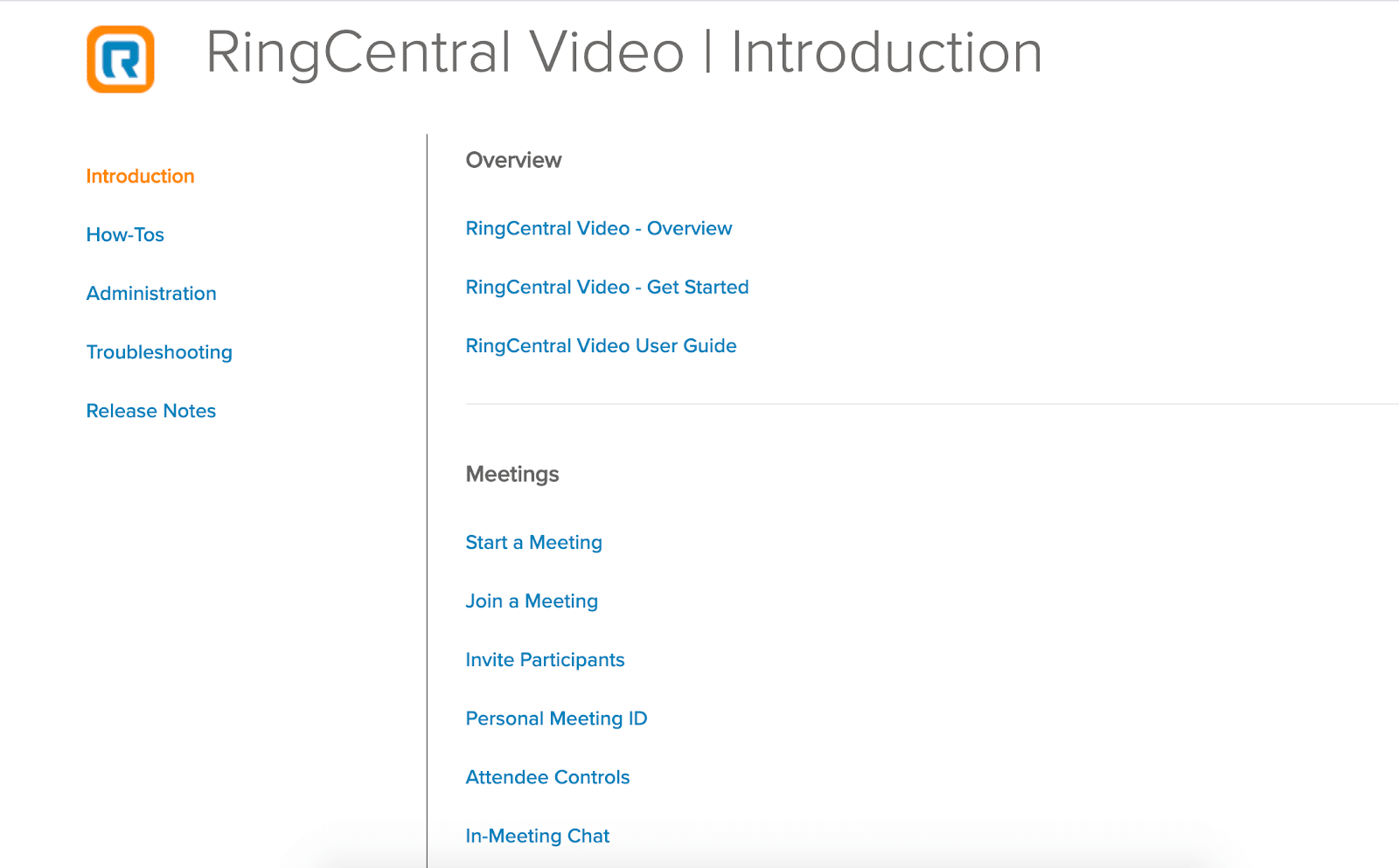
RingCentral’s knowledge base, which lets customers find answers to commonly asked questions whenever they want.
- Omnichannel: The customer’s preferred support channel will often depend on the type of question they have. For example, 40% of people prefer to resolve more complex issues like payment disputes over the phone.16 Again, having an omnichannel customer service solution like RingCentral here will let your customers seamlessly switch from one contact channel to another.
9. Continuous improvement
You should continuously look for new ways to refine your level of customer service. There will always be things you can do better.
To do this, you need to pay close attention to operational data and customer feedback.
Negative reviews often contain valid insights that you can act on to improve your service. You should value these complaints as much as you do positive feedback since 91% of unhappy customers will simply leave without complaining.17
Factors affecting improvement:
- Collect and analyze customer feedback: Here are some places where you might find golden nuggets of customer feedback: surveys, reviews, live chat transcripts, customer sales calls, recorded website sessions, and social media mentions.
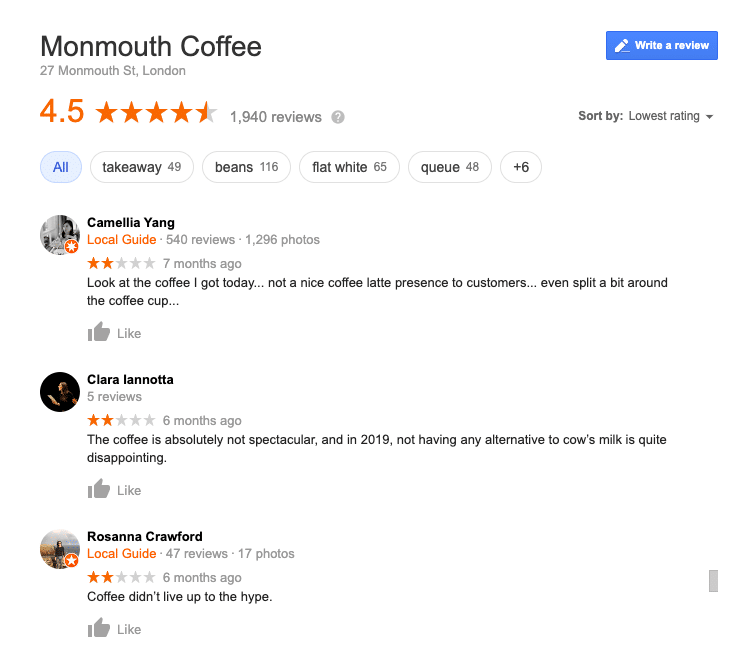
Monmouth Coffee is a well-loved coffee shop in London. The handful of poor reviews on Google contain ideas of how they could improve their service.
- Business intelligence: To improve your overall service, you need to always be monitoring your operational data. For example, you could use RingCentral’s call reporting data to ensure your call centers are staffed when volume is highest.
3 real-life examples of customer service philosophy in action
1. Disney
Disney is perhaps the gold standard of customer service.
The company obsesses about providing magical experiences to its customers, and its incredible 70% return rate for first-time visitors speaks for itself.18
Disney even runs its own institute (The Disney Institute) to help service professionals from other companies improve their customer experience.
So, how does Disney work its magic?
For Walt Disney, the secret to quality service lay in the constant improvement of mundane processes and careful attention to detail.
This philosophy remains at the heart of the company to this day.
For example, Disney found that some children would wait in line for a ride only to find out they were too short to get on (despite efforts to make height-restrictions clear and obvious). To turn these situations into positive experiences, Disney now gives these children a special pass to skip to the front of the line for their next ride. (We tried to find you a photo of these fabled passes to show you what they look like, but alas…)
In another example of process optimization, Disney found that many customers leaving the park would struggle to find where they left their cars in the enormous parking lot. The solution was to fill the parking lot each morning in a particular order and give guests a note of their arrival time. That way, at the end of the day, leaving guests could simply let the park tram operators know what time they had arrived in order to be dropped off in the right place.
Disney also emphasizes the importance of employee knowledge, tone, and body language in service delivery. Employees (or “cast members”) must stay true to their roles in front of guests. For example, if you ask Cinderella, “Hey, can I take a picture of you with my iPhone?”, you might expect her to reply, “What’s an iPhone?”—thereby staying in character.
2. Zappos
Zappos is another company with a legendary reputation for customer service.
The company prides itself on being a service company first and a clothing and footwear company second.
Zappos’s mission to continually “WOW” customers and offer the best solutions possible spills into every aspect of their customer service.
For example, customers can speak with an agent for as long as they want. Zappos has no restrictive call time parameters. In fact, the company’s record for longest customer service call is 10 hours, 51 minutes!19
Zappos’s Customer Loyalty Team is known for its big, customer-delighting gestures. Each year, the team sends out 13,000 custom-illustrated greeting cards directly to customers, for weddings, birthdays, and other special occasions.
By doing all they can to go above and beyond for their customers, Zappos succeeds in building long-term relationships and a truly loyal customer base. That’s why 75% of purchases through Zappos come from returning customers.20
Rob Siefker, Senior Director of Customer Loyalty at Zappos, explains simply why the company is so obsessed with impressing its customers: “People will not choose your business if you don’t provide them great service”.
3. Trader Joe’s
Trader Joe’s is yet another company known for its excellent customer experience.
In fact, Trader Joe’s was the only national grocery store to rank top in Consumer Reports 2019 customer satisfaction survey.21
Each store has a welcoming, neighborhood feel to it, and the staff are famously cheerful and eager to help customers.
Store managers spend most of the day on the retail floor interacting with customers, while store assistants respond to every customer need, readily offering taste-tests to undecided shoppers.
Of course, this level of service is no accident.
CEO Dan Brane lists seven core values that each new team member adopts when they join the company22:
- Integrity
- Product-driven company
- WOW customer service (Sound familiar?)
- No bureaucracy
- Kaizen (a Japanese word that means “continuous self-improvement”)
- The store is the brand
- We’re a national chain of neighborhood grocery stores
Ready to define your own customer service principles?
Top-notch customer service is an essential pillar for any customer-facing business.
It’s a key that unlocks some of the finest prizes on offer when growing a business: customer loyalty, brand advocacy, and rich customer feedback.
Poor customer service, on the other hand, can lead to dire consequences for your brand.
Your customer service strategy should be informed by an underlying customer service philosophy. This set of principles embodies your company values and will guide your employees in every customer interaction they have.
1 zendesk.com/resources/customer-service-and-lifetime-customer-value
2 experiencematters.blog/category/roi-of-customer-experience
3, 10 salesforce.com/research/customer-expectations
4, 5, 12, 16 about.americanexpress.com/press-release/wellactually-americans-say-customer-service-better-ever
6 https://www.salesforce.com/products/service-cloud/best-practices/customer-retention-rate
7 ameyo.com/blog/customer-experience-statistics-which-will-impact-your-business-in-2016
8, 13 info.microsoft.com/rs/157-GQE-382/images/EN-CNTNT-Report-DynService-2017-global-state-customer-service-en-au.pdf
9 go.forrester.com/blogs/11-07-16-a_consistent_customer_experience_requires_consistency_in_managing_voice_electronic_and_social_interac
11customerthermometer.com/customer-service/customer-service-and-satisfaction-statistics-for-2020
14 bizreport.com/2015/04/report-poor-customer-service-pushes-consumers-away.html
15 slideshare.net/stevenvanbelleghem/the-self-serving-economy/13
17 huffpost.com/entry/50-important-customer-exp_b_8295772
18 huffpost.com/entry/how-disney-creates-magica_b_7093682
19 zappos.com/about/stories/record-call
20 sharpencx.com/blog/zappos-customer-service
21 consumerreports.org/grocery-stores-supermarkets/best-grocery-stores-and-supermarkets
22 traderjoes.com/TJ_CMS_Content/Images/Digin/pdfs/InsideTJs-Episode2-Transcript.pdf
Originally published Mar 02, 2020, updated Jul 25, 2024


